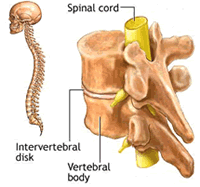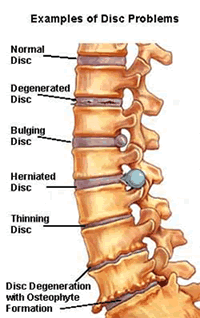|
|
Spinal (cord/column/disc) Support Remedy
 |
The spinal cord is a long, thin, tubular bundle of nerve tissue and support cells that extends from the brain (the medulla oblongata specifically). It begins at the occipital bone and extends down through the protective spinal column to the space between the first and second lumbar vertebrae. It does not extend the entire length of the vertebral column. The brain and spinal cord together make up the central nervous system (CNS).
The spinal cord functions primarily in the transmission of neural signals between the brain and the rest of the body. The anatomy of the spinal cord itself consists of millions of nerve fibers which transmit electrical information to and from the limbs, trunk and organs of the body, away from and back to the brain. The nerves within the spinal cord are grouped together in different bundles called Ascending and Descending tracts. Ascending tracts within the spinal cord carry information from the body up to the brain, such as touch, skin temperature, pain and joint position. Descending tracts within the spinal cord carry information from the brain downwards to initiate movement and control body functions.
The spinal cord is surrounded by the Cerebral Spinal Fluid. The fluid acts as a cushion to protect the delicate nerve tissues against damage from hitting against the inside of the vertebrae. All of this is safely protected inside the spinal column in bony segments called vertebrae. The human spinal column is made up of 33 bones: 7 vertebrae in the cervical region, 12 in the thoracic region, 5 in the lumbar region, 5 in the sacral region and 4 in the coccygeal region. In adults the bones in the sacral region join to form one bone called the sacrum; the bones in the coccygeal region join to form one bone called the coccyx. Some believe, and I tend to agree, that if a proper lifestyle of exercise, diet and flexibility were maintained from childhood, most of these bones would not fuse and the body would remain much more limber and less prone to injury.
NOTE: Spinal disorders are the single greatest cause of disability in the working population. They are the second most frequent reason for a doctor visit and the third most common reason for surgery. People who have back pain and do not specifically retrain their deep back muscles are 22 times more likely to have a reoccurrence of back pain in the following three years.
The vertebral disc in the spine is an interesting and unique structure. Its primary purpose is to act as a shock absorber between adjacent vertebrae. Spinal discs also act as ligaments that hold the vertebrae of the spine together and as cartilaginous joints that allow for slight mobility in the spine. There are a total of twenty-three vertebral discs in the spinal column. Specific problems with any of these discs may prompt different symptoms, including back pain, neck pain and sciatica. Spinal Disc Construction: Discs are actually composed of two parts: a tough outer portion and a soft inner core, and the configuration is like that of a jelly doughnut. The outer portion of the disc (annulus fibrosus) is the tough circular exterior composed of concentric sheets of collagen fibers (lamellae) that surround the inner core. The inner core (nucleus pulposus) contains a loose network of fibers suspended in a mucoprotein gel.
There are 23 discs in the human spine: 6 in the neck (cervical region), 12 in the middle back (thoracic region), and 5 in the lower back (lumbar region). With exception to injuries, the primary reason people get spinal disc issues are due to dehydration and the body running low in enzymes.
Fun Facts
- The spinal cord is around 45 cm (18 in) in men and around 43 cm (17 in) long in women.
- There are 31 pairs of spinal nerves.
- The spine contains over 120 individual muscles, 220 specialized ligaments and over 100 joints.
- Cartilage makes up 25 percent of the spine's length.
- Cerebral spinal fluid turns over (new volume is made) 3.7 times a day!
- Cartilage disks expand in the absence of gravity -- The Skylab astronauts grew 1.5-2.5 inches due to spinal lengthening as a result of zero gravity. Gravity also causes these disks to compress over time. People shrink between a quarter of an inch and five inches every decade after 40. You are taller in the morning than at night due to temporary, daily compression of these disks.
- Over 250,000 Americans have a spinal cord injury with 82 percent being males. Spinal cord injuries are mostly commonly caused by: Motor vehicle accidents (48%), Falls (21%), Violence (15%), Sport-related injuries (14% - two thirds of these are from diving).
Health Conditions
- Misalignment of the vertebrae (subluxation) can cause nerve impingement. Many use Chiropractic to help this condition (I am not particularly in agreement with traditional Chiropractic manipulation techniques).
- Spinal cord injuries can change the amount of nerve transmission and affect strength, sensations, etc. In more severe injuries, nerves are unable to transmit any information and an area will become paralyzed (lose all function).
- Most of the health conditions, once injuries are ruled out, are from various viral and bacteria that can enter the spinal column and affect the smaller nerve bundles causing meningitis.
Suggestions To Strengthen
- Stay well hydrated.
- Make sure you are eating good salt, like Celtic sea salt. Sodium (like regular table salt) is bad for you, salt is an essential mineral.
- Avoid jobs and hobbies that could lead to injury.
- Get out of your chair and move! Keep the muscles healthy and cartilage flexible with regular movement.
- Practice the correct way to lift objects. Lifting the incorrect way can make you susceptible to spinal disc problems. Place pressure on your legs and avoid lifting by using your back muscles.
- Maintain good posture. Poor posture makes a person more susceptible to degenerative disc disease. Sit with your shoulders back and your spine straight.
- Maintain a healthy weight. Overweight and obese individuals are more at risk for developing spinal disc problems because of the added stress on the back.
|
|
| |
Spinal Cord/Disc Support Remedy
Complete support remedy for Spinal Cord and related functions
$14.95
|
 Add
To Cart Add
To Cart |
 |
 |
Gallbladder Support Remedy
Complete support remedy for Gallbladder and related functions
$14.95
|
 Add
To Cart Add
To Cart |
 |
 |
Brain Support Remedy
Complete support remedy for Brain and related functions
$14.95
|
 Add
To Cart Add
To Cart |
 |
 |
Large Intestine Support Remedy
Provides support and healing for conditions of the large intestine
$14.95
Read/Write Reviews
|
 Add
To Cart Add
To Cart |
 |
 |
|
|




